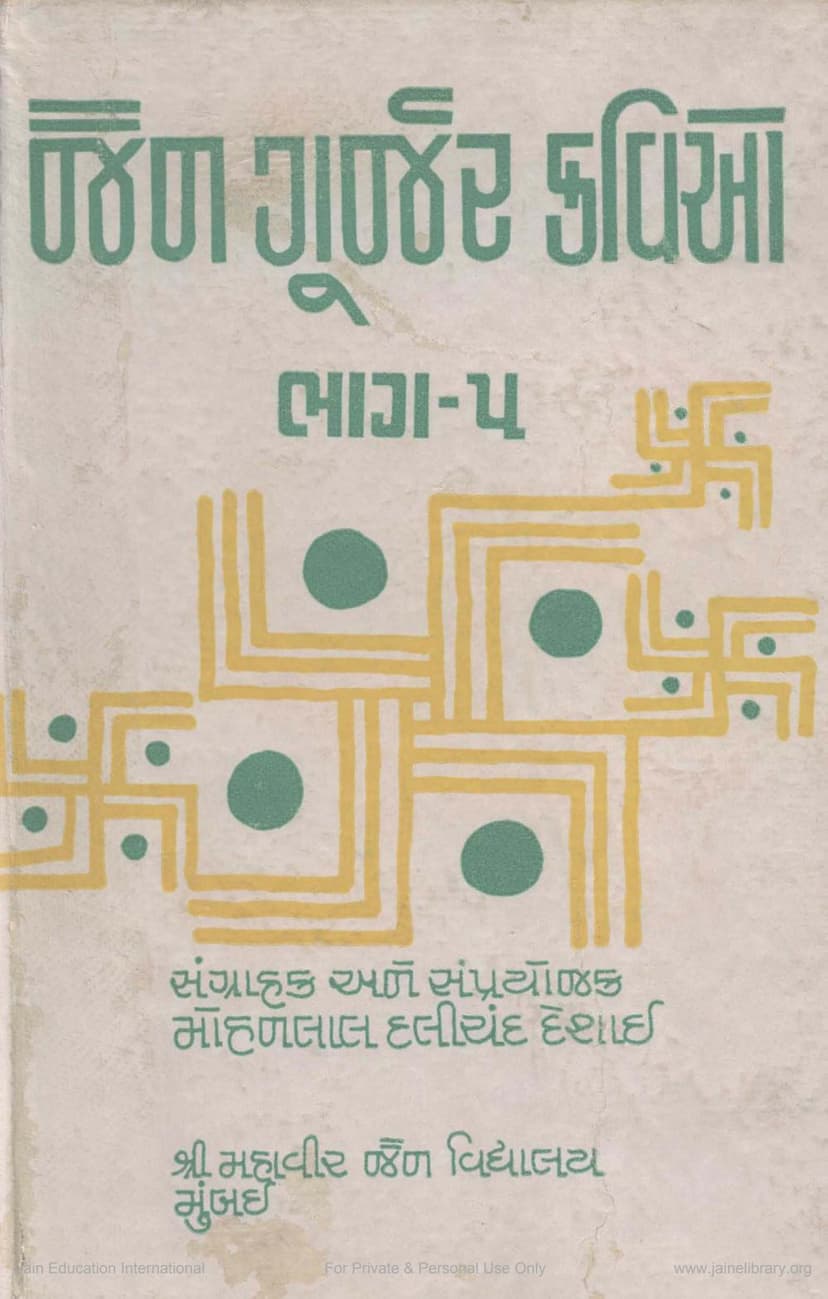Jain Gurjar Kavio Part 05
Added to library: September 2, 2025

Summary
This document is a detailed catalog of Jain poets and their works in the Gujarati language from the 18th century (Vikram Samvat 18th century). It is the fifth volume of the "Jain Gurjar Kavio" series, compiled by Mohanlal Dalichand Desai and revised and expanded by Jayant Kothari. Published by Shri Mahavir Jain Vidyalay, Bombay, in May 1988, this volume serves as a comprehensive index, listing poets chronologically with their works, manuscript details, and publication references.
Here's a breakdown of the content based on the provided pages:
-
Title and Publication Information: The book is titled "Jain Gurjar Kavio," Volume 5. It was compiled by Mohanlal Dalichand Desai and revised and expanded by Jayant Kothari. The publisher is Shri Mahavir Jain Vidyalay, Mumbai, and the publication date is May 1988. The catalog link provided is to jainqq.org.
-
Scope: The volume focuses on Gujarati Jain poets of the 18th century (Vikram Samvat), specifically detailing their works. It's noted as "Part II" of a larger listing, suggesting this is a continuation.
-
Codification System: Page 4 shows a crucial section explaining the "Explanation of Ciphers" (સાંકેતિક અક્ષરોની સમજ). This lists various libraries and collections where manuscripts were found, along with their abbreviations (e.g., અલવર રાજની લાયબ્રેરી - અલ., કસ્તુરસાગરજી ભંડાર, ભાવનગર - ક.ભં., જૂના સંધ ભંડાર, પાટણ - જૂ.સં.ભં.પા.). This is essential for understanding the sourcing of the cataloged works.
-
Corrections and Additions: Page 6 lists "Important Corrections and Additions" (મહત્ત્વની શુદ્ધિવૃદ્ધિ) made in this revised edition, indicating meticulous attention to accuracy.
-
Table of Contents (Anukramanika): Pages 7-12 present the detailed table of contents, listing poets by their serial numbers (starting from 990. Shantidas and going up to 1228. Ajnat) and the page numbers where their entries begin. This demonstrates the vast scope of the work, cataloging hundreds of poets.
-
Poet Entries: The subsequent pages (13 onwards) provide individual entries for poets. Each entry typically includes:
- Poet's Name: Often with lineage or affiliation (e.g., શ્રાવક - lay follower, શિષ્ય - disciple of X, વા. - Vachak).
- Work Title: The name of the poem, hymn, or treatise.
- Genre/Type: Indicated by terms like રાસ (Ras), ચાપાઈ (Chaupai), સ્તવન (Stavan), સઝાય (Sajhay), કથ (Katha), બાલા (Bala - simpler poetry), પ્રકરણ (Prakaran - treatise), ટીકા (Tika - commentary), etc.
- Manuscript Details: Often includes abbreviations for the source library/collection, and sometimes manuscript numbers.
- Date of Composition/Completion: Indicated by ર.સં. (rachana samvat - composition year) or similar notations, often with specific month, day, and weekday.
- Location: Sometimes mentions the city or place of composition.
- Invocation/Salutation: Entries often begin with invocations to Jain Tirthankaras, Gurus, or Goddess Saraswati.
- Content Snippets: For many entries, a few lines from the beginning or end of the work are quoted, giving a glimpse into the poetic style and content.
- Editorial Notes: Some entries include bracketed notes ([ ]) from the editors, providing cross-references, corrections, or additional information.
-
Content Focus: The entries detail a wide range of poetic and literary forms. The works are predominantly religious, devotional, and didactic, focusing on the lives of Jain figures (like Gautam Swami, Jambu Kumar, Rishabh Datt, Dhandh, etc.), ethical teachings (like the importance of Ahimsa, Dana, Sila, Tap), philosophical concepts (like Navatattva, Karma), and hymns or praises of Tirthankaras and Jain Tirthas. The language is Gujarati, often in a poetic or rhyming style (Chaupai, Doha, Gajal, Sijhay).
-
Methodology: The catalog seems to be a descriptive bibliography, aiming to provide a comprehensive list of poets and their literary output during a specific century, based on manuscript research and existing literature.
In essence, "Jain Gurjar Kavio Part 05" is a scholarly and invaluable resource for anyone studying the history of Gujarati literature, Jain religious literature, manuscript studies, and the socio-cultural landscape of Gujarat during the 18th century Vikram Samvat. It meticulously documents the rich literary tradition of Gujarati Jain poets.